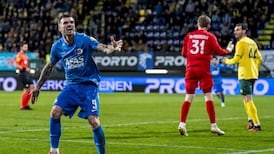In Focus Munich Arena: Tom Humphries is bowled over by an already iconic giant bubble that positively glows
Driving in from Munich's stunningly antiseptic airport there are strange sights to be seen. As you hit the autobahn a stunningly large representation of a diving Oliver Kahn forms an arch over the road for you to drive under.
If that's the sort of effect you usually like to get with expensive hallucinogenic drugs there is more good news farther down the road. From just behind an upcoming bridge you can see the curve of a massive white tractor tyre which has apparently been deposited on the roadside by aliens. You can drive by the Allianz Arena and rubberneck for as long as it's safe and never figure it for a football stadium.
It's not beautiful but it's memorable and it's iconic. Wrapped in what looks like bubble wrap, the Arena (denuded of its sponsor's name for the World Cup) is designed to put the football back at the centre of the stage.
It is a stadium with an exterior skin which makes a statement and an interior which holds noise and creates atmosphere.
It is not a daunting place. The slight eeriness of the exterior doesn't prepare you for the genuine communal feeling the inside brings.
In that sense the Arena is a glorious con job. Rejecting the movement towards a return to the sort of stadia which generate urban growth and stimulate communities around them, the Germans have plonked their masterpiece down at Frottmaning, a so what northern suburb of Munich.
It sits there virtually unreachable by foot just off the city's ring road. You get there by U-Bahn or by car or you stay at home. The venue is entirely disconnected from the city it serves.
Yet when you plug it in with a crowd roaring on the inside, translucent lights glowing on the outside, you have the illusion that the game is once more a communal experience, a great social event which illuminates a city and a life.
Everyone is crowded close to the action, the noise is an entity in itself. You could imagine the thousands who stream out when the referee toots the full-time whistle will be better citizens than when they came in. You could imagine a community around this.
Quite an effect, to trap a football crowd inside a giant bubble created from 2,816 inflatable cushions. The cushions are of different sizes and are pumped with air. The material used is ETFE (as you are undoubtedly thinking right now, ethylene tetrafluoroethylene, a fluorocarbon-based polymer that, in sheet form, weighs less than 1 per cent of the equivalent pane of glass.) The cushions can glow red, white or blue, or any combination of all three depending on who is playing at home. (Bayern are red. 1860 are blue. Germany are white).
Those polymers don't just give the stadium a pretty face. They can withstand a fall of 1.6 metres of snow and eliminate just five per cent of the daylight, giving the interior a novel sense of light.
There the novelty ends, though. Inside, the Arena is a sturdy and traditional football ground. Three tiers, holding 66,000 spectators, stack one over the other close to the pitch. The innards are massive steel cantilevers hoisting the building to a height of 50 metres and holding its 104 corporate boxes, its 28 snack kiosks and its two massive dining halls.
Then there's the shops, the kindergartens and the conference rooms.
Munich, of course, already has a beautiful, iconic stadium. From everywhere in town you can see the massive but slender TV tower out at the old Olympic Park and underneath it, the wonderful cable net roof of architect Gunter Behnisch's 80,000 seater Olympic Stadium, home of the 1972 Games.
Behnisch was offered the chance to add some bells and whistles to the lovely old amphitheatre for this World Cup but he felt it would be inappropriate. The city offered to leave all 915,000 square feet of the roof intact but to rebuild the stadium underneath. Behnisch said no and under German law that veto remains his right for 70 years.
The organising committee had no choice but to build a new stadium elsewhere.
Behnisch built the stadium with the engineer Oto Frei and its lightness and its flow were a riposte to the monumental oppressiveness of the 1936 Olympic Stadium in Berlin. Some irony, then, that Behnisch's refusal to tamper with his masterpiece ensured this year's tournament begins in the bloodlessly modernistic Arena and finishes when the final brings the game back to Werner March's dark and joyless coliseum in Berlin.
When Munich took the painful decision to build a new stadium it was inevitable they would engage, as is the fashion these days, superstar architects. Jacques Herzog and Pierre de Meuron are a pair of shaven- headed Swiss football fanatics who have designed the Prada shop in Tokyo, the Tate Modern in London, the sea-front Forum in Barcelona and the Stadium in Basle where Ireland played twice in recent years.
The pair are working on a stadium which will make the Arena look like an easy gimmick. The 100,000-capacity Beijing Olympic Stadium is being built in the style of a bird's nest with all its structural members intertwined to create a basket. There won't be one perpendicular column in the stadium and the strands of the basket will be filled by transparent panels.
Tonight, meanwhile, the World Cup opens in a 66,000-seater talking point; love it or loathe it, the Arena it will become an icon of the city.









